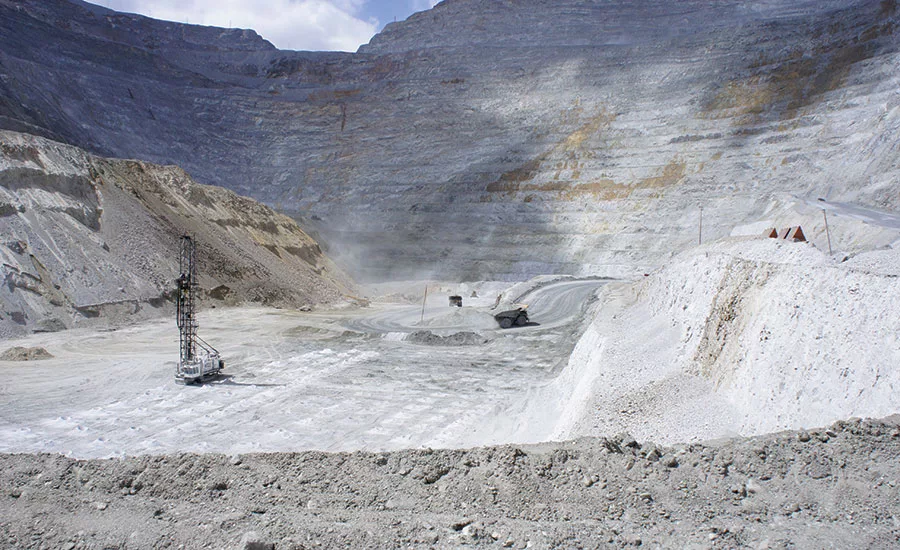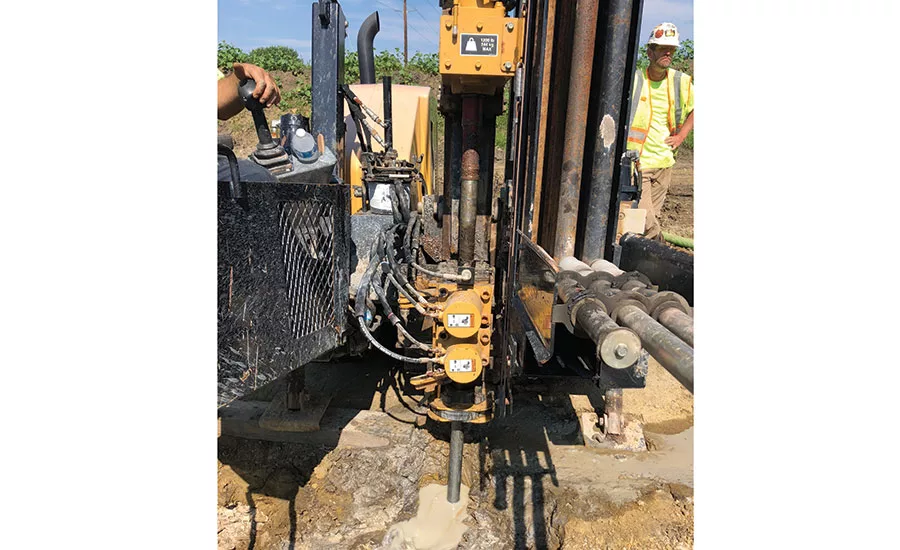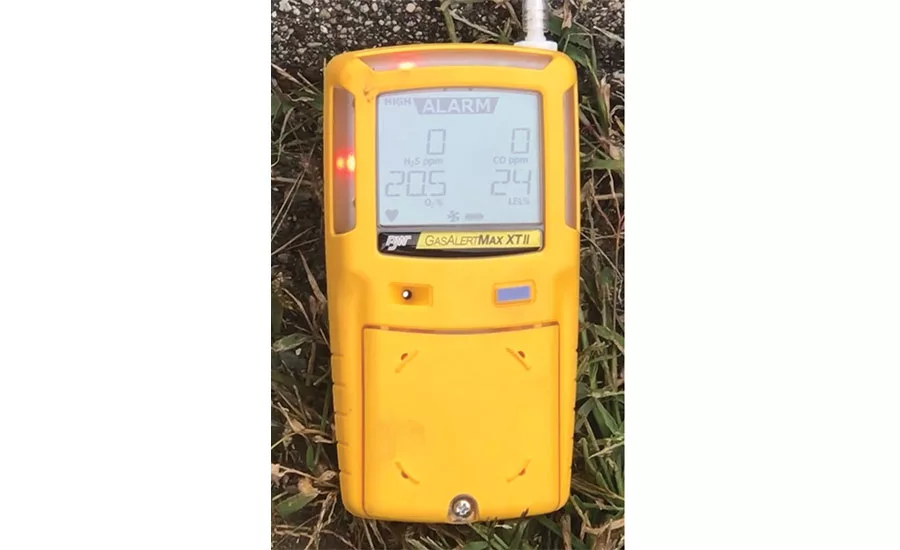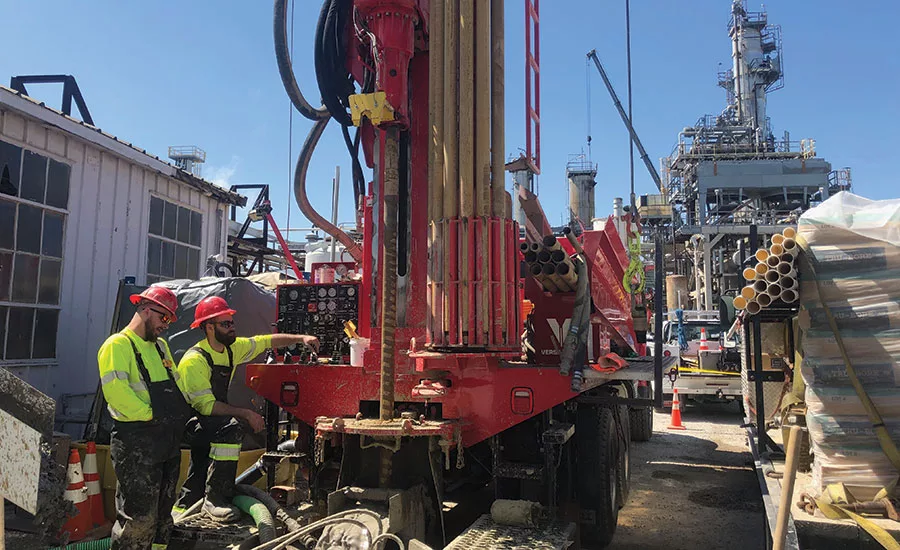On Drilling Jobs, Prevention Can Minimize Hazards, Injuries

How remote was your last jobsite? If it takes more than three or four minutes to get EMS to the scene, it’s best to have personnel on site trained in first aid.
Source: Brock Yordy photos

More and more, rigs feature safety cages that keep drillers out of hazard areas where moving equipment can cause serious injury.

Suffocation doesn’t just happen in enclosed spaces. A portable air quality meter can identify both combustible and toxic gases before they overwhelm crews onsite.

A good Job Safety Analysis should cover steps to safely execute a drilling project, regardless of whether it’s on an industrial site or a remote farm.
Source: Brock Yordy photos
In the drilling industry, the individual with the newest tool is king. We tool up our rigs, service trucks and pickup trucks with a wide range of specialty tools. The plan is to have the right tool to overcome any problem that arises onsite. That problem could be as simple as a broken hydraulic line or as complicated as a fishing tool to recover drill steel downhole.
When it comes to being prepared, the right tool can turn around a bad situation. Now consider the amount of money your company spent on specialty tooling this year. How many of those tools were for jobsite first-aid and safety gear? More importantly, what is in your field first-aid kit and how many team members understand how to administer care? Specialty tools become useless objects when the operator is incapacitated or dead.
OSHA’s regulations state that, for workplaces where serious accidents such as those involving falls, suffocation, electrocution or amputation are possible, emergency medical services should be three to four minutes away, otherwise an individual onsite must be trained in first aid and CPR. I want you to think about your past 10 jobs. How many of them had EMS less than four minutes away? The serious accidents just mentioned are common hazards on any drilling project. Our drill teams must be appropriately trained to administer care when a member is injured on site. Immediate response to a serious injury can avoid permanent damage and death. In my May 2016 article “Emergency Action Plans Keep Drilling Jobs Safe,” I discuss the proper steps for calling 911, administering first steps to aid, and what to do with an equipment fire. Today, I want to drill deeper into how to properly prevent and to be prepared for these severe incidents.
Falls
Fall prevention starts with a proper job safety analysis of the jobsite. After the analysis, create a safety plan that clearly defines fall hazards and adequate fall protection for those hazards. That can be as simple as installing guard rails, or be more complicated with requirements for the use of personal fall protection equipment. Men and women utilizing a body harness must have proper training on their equipment, including adequate inspection, care and utilization. Every year, I learn about a half dozen fall injuries and fatalities that occur from faulty harnesses or the employee’s failure to properly connect to an approved anchor. Over 90 fatalities have occurred from falls in the past eight years in the drilling industry. Proper training and equipment utilization could have prevented a majority of those falls.
Suffocation
It’s hard to consider suffocation as a hazard in drilling when often we visualize standing on the drill platform in an open field with the wind blowing. However, the two significant suffocation hazards we encounter are confined spaces such as pits and subsurface drilling operations.
Prevention starts with utilizing an air quality monitor on the rig and any time you enter a confined space. An air quality meter should test for the percentages of oxygen, combustible gases and toxic gases. All team members working in suffocation hazard conditions should be properly trained on how to utilize their specific air quality meter, and also in how to test the meter before use. In 2018, there were 217 fatalities caused by confined-space asphyxiation. In many situations, more than one employee was lost due to colleagues attempting a rescue without proper equipment. Confined spaces must be respected with appropriate planning and training, and an emergency action plan in place for rescue.
Electrocution
Fatalities from electrocution in the drilling industry are prevalent. Dave Bowers wrote about a situation in March 2019 of rising a rig’s mast into a power line. It seems very straightforward to have a safety program that requires employees to look up before setting up the mast. Next, contractors on every drilling project should perform due diligence by contacting local locating 811 providers to ensure that there isn’t a subsurface hazard on site. Proper site evaluation can prevent a drill crew from encountering a power utility. In May 2018, two men were electrocuted in Colorado when their rig’s mast made contact with a 12,500-volt powerline.
Beyond drilling, the more common cause of electrocution fatalities comes from working on pumping systems. Again, prevention is the key to keeping everyone safe. It starts with a proper lock out/tag out procedure before working on any electrical system. Next, it is essential for team members to have appropriate protective gear and electric testing equipment to prevent working on a live circuit. I was taught to treat every line as if it was active. In 2018, there were 71 fatalities in this industry due to electrocution.
Amputation
Drill rigs are designed to dismember anything, be it the ground or a human being. OSHA recognizes amputation hazards as any piece of equipment that has moving components. This includes components that perform rotating, reciprocating, cutting, shearing, punching and drilling functions. These are all actions found on a drill rig and a leading cause of injury and fatality on jobsites.
Prevention starts by acknowledging danger zones by utilizing a Job Safety Analysis (JSA) and then creating areas of exclusion while the rig is in operation. Drillers and helpers need to have a heightened level of situational awareness, always thinking about potential crushing and rotational hazards. Team members also need to have each other’s safety in mind by still being on the lookout for moments when their colleague enters a danger zone. In the past 10 years, here are a few incidents that fit into this category:
- An employee’s finger is amputated while drilling.
- An employee is struck by hoisted material and has his leg crushed.
- A rotating auger severs an employee’s arm.
- An employee is killed by spinning wrench.
- An employee is caught in rock drilling machine and killed.
These types of casualties and risks can all be minimized by proper use of a JSA and through crew awareness of potential hazard areas.
Medical Attention
When prevention fails and a team member is injured, their well-being depends on swift action. First, it is vital to know the distance to and response time from the closest emergency medical service. Next, every job should have more than one American Red Cross-certified first responder. Over the past 10 years of working with the U.S. military’s drilling units, I have had several discussions with medics about proper first-aid kits and care on drilling sites. Every conversation leads to the same conclusion: The drilling process presents just as many hazards as the front lines in a combat zone. A first-aid kit should include everything to combat burns, eye injuries, snake bites and lacerations, have tourniquets/compresses for excessive bleeding, and feature detailed instructions for treating an unresponsive employee with multiple levels of trauma.
OSHA requires many remote working construction trades, such as logging, electrical linemen, pipelines and exploration mining, to have more complex triage first-aid kits and staff that can stabilize an injured team member while help is more than 15 minutes away. At the minimum in areas where EMS is less than 10 minutes away, first responders should be prepared to aid in serious injuries involving stopped breathing, uncontrolled bleeding and cardiac arrest. In these situations, the first few minutes of aid can help prevent permanent medical impairment and death.
A good safety program documenting near misses and the creation of detailed JSAs for field work are the best ways to combat and prevent severe injury. Daily safety meetings and taking time to check in with every team member on site can also prevent jobsite incidents. The number of 21st-century distractions that can invade our jobsites is endless. As odd as it sounds, a jobsite incident could start as a distracting text message like “grandma is being rushed to the hospital with chest pains” or a gossipy social media post that a coworker’s partner is unfaithful. That is why the stop work authority is one of the essential first-aid tools in our kit. Stop work authority allows anyone to prevent an injury if they see unsafe practices. Finally, training for a catastrophic incident with a drill team is a perfect way to know if everyone is prepared. The worst situation is having the right tool on site to save a life but lack of team coordination to make a timely save.
Looking for a reprint of this article?
From high-res PDFs to custom plaques, order your copy today!





